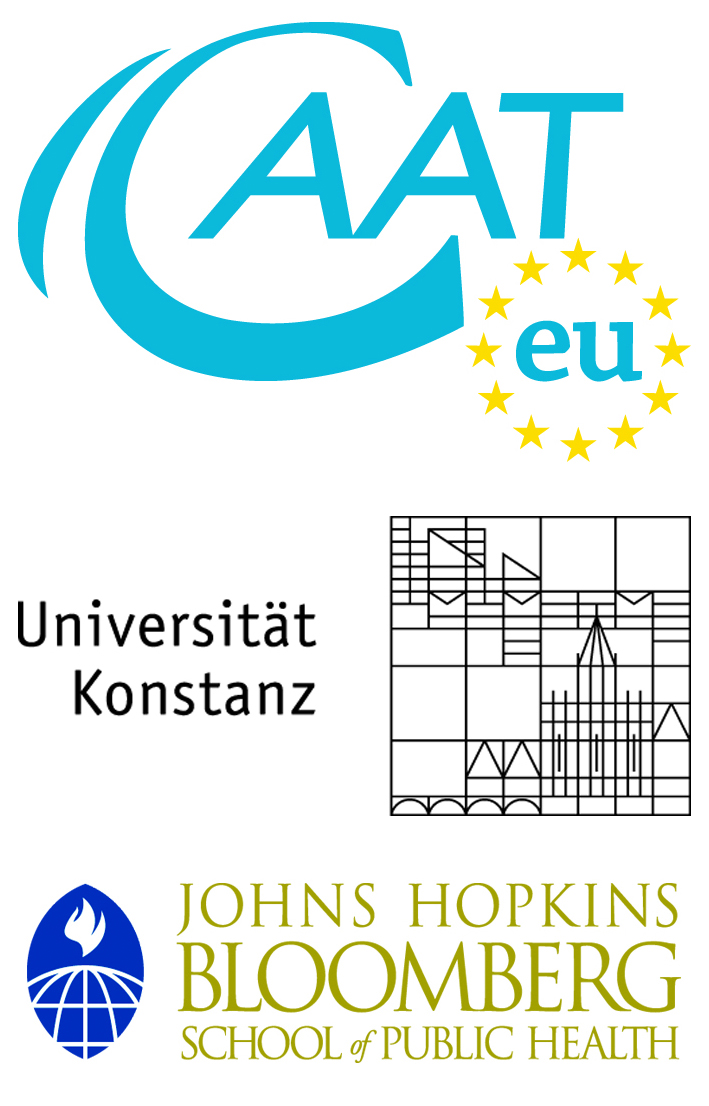Metabolomics in toxicology and preclinical research
CAAT-Europe - BASF Symposium

February 13 th 2012 in Berlin, Germany
The Chemical Company BASF SE and the Centre of Alternatives to Animal Testing – Europe (CAAT-Europe) invited to the Symposium on ‘Metabolomics in Toxicology and preclinical research’. The focus of the symposium was on the state-of-the-art und potential applications of metabolomics in toxicology and preclinical research.
Outline:
In order to meet the challenges of the toxicology of the 21st century, it is essential to
understand the molecular pathways underlying the toxic effects of chemical, agrochemical or pharmaceutical compounds. To address this challenge, it is crucial to use innovative methodologies that enable scientists to obtain the highest-possible information from a biological system. Metabolomics, as compared to other -omics approaches, can be considered as being the closest of the ‘-omics sciences’ to classical toxicology, while providing information on a high level of integration enabling us to
1) Improve our understanding about the toxicological profile of a given compound; i.e. identifying its toxicological mode of action(s)
2) Identifying biomarkers that can potentially be used to identify pathophysiological
conditions or in cases of drugs used for treatment monitor efficacy of treatment
3) Identify biochemical pathway changes following exposure
The metabolomics technology is particularly suitable to be applied using body fluid matrices, such as urine and blood, enabling comprehensive insights into metabolic responses to e.g. chemical exposure without analyzing individual organs. In toxicology the first applications have been for mechanistic research and early identification of toxicological effects.
Recognition and understanding the cause of (patho)toxicological effects based on
identification of mode of action(s) will greatly enhance the quality of toxicological studies and aid the risk assessment process. Moreover, overall comparisons of metabolome profiles of chemicals should provide comprehensive biological information which will enable us to build better chemical categories for safety assessment. Finally, based on the successful application of metabolomics in chemically induced toxicity, it should be feasible to use this technology for the identification of diseases.
This Symposium brings together scientists from academia, industry and regulatory bodies to present the current status of this technology and its applicability in toxicology , particularly for safety assessment of compounds.
Agenda: Symposium Metabolomics in Toxicology and Preclinical Research: State-of-the art and potential applications
09:00-09:20 Introduction: Thomas Hartung, Johns Hopkins University, CAAT, USA, and Ben van Ravenzwaay, BASF SE, Germany
09:20-09:40 "Metabolic profiling approaches in toxicology", Dr. Harald Jungnickel, BfR, Germany
09:40-10:00 "Role of Metabolomics in Environmental Chemical Exposure and Risk Assessment", Dr. Drew R. Ekman, EPA, USA
10:00-10-20 ”The use of metabolomics for chemical grouping”, Dr. Henicke Kamp , BASF SE, Germany
10:20-10:40 “Towards fit for purpose metabolomics for read-across under REACH”, Dr. Elwin Verheij, TNO, the Netherlands
11:10-11:30 “Mode of action identification”, Dr. Bennard van Ravenzwaay, BASF SE, Germany
11:30-11:50 “Mapping the Human Toxome”, Prof. Thomas Hartung, Johns Hopkins University, CAAT, USA
11.50-12:10 “Identifying Pathways of Toxicity for Developmental Neurotoxicology”, Dr. Helena Hogberg, Johns Hopkins University, CAAT, USA
12:10-12:30 “Metabonomics: Some results and conclusions from samples of asthmatic children”, Dr. Claude Guillou, EC JRC, Italy
13:40-14:10 „Statistical Analysis of Metabolomics data”, Dr. Gerhard Krennrich, BASF SE, Germany
14:10-14:30 “Omics data integration in systems biology models”, Prof. Frederic Y. Bois, INERIS/DRC/METO, France
14:30-14:50 “Software for Pathway Informed Metabolomics“, Dr. Steve Fischer, Agilent Technologies, USA
14:50-15:10 “Metabolomics and metabolic flux analysis in toxicological research”, Dr. Fozia Noor, Saarland University, Saarbrücken, Germany
15:10-15:30 “Practical Metabolomics – Many Challenges, Some Solutions”, Dr. Mark Seymour, Syngenta AG, UK
15:50-16:10 “NMR-based metabonomics and pharmacometabonomics applied to toxicology“, Dr. Muireann Coen, Imperial College London, UK
16:10-16:30 "NMR-based metabolic profiling in preclinical models: (COMET) project", Dr. Hector Keun, Imperial College London, UK
16:30-16:50 “Ex-Vivo 3D Skin Models by Mass Spectrometry Imaging and Profiling”, Prof. Malcolm Clench, Sheffield Hallam University, UK
16:50-17:10 “Stem Cell Based Assays and Metabolomics for Predictive Toxicology”, Dr. Beth Donley, Stemina, USA
17:10 Closing remarks BASF, Dr. Tzutzuy Ramirez, Development of Alternative Methods;
Contacts:
BASF: Dr. Tzutzuy Ramirez-Hernandez, Development of Alternative Methods, tzutzuy.ramirez-hernandez@basf.com; Postal Address: BASF SE Experimental Toxicology and Ecology 67056 Ludwigshafen, Germany
CAAT-Europe: Dr. Mardas Daneshian, CEO of Center for Alternatives to Animal Testing-Europe, caat-eu@unikonstanz.de; Postal Address: CAAT-Europe, University of Konstanz, Universitaet Str. 10, POB 600, 78457 Konstanz, Germany
